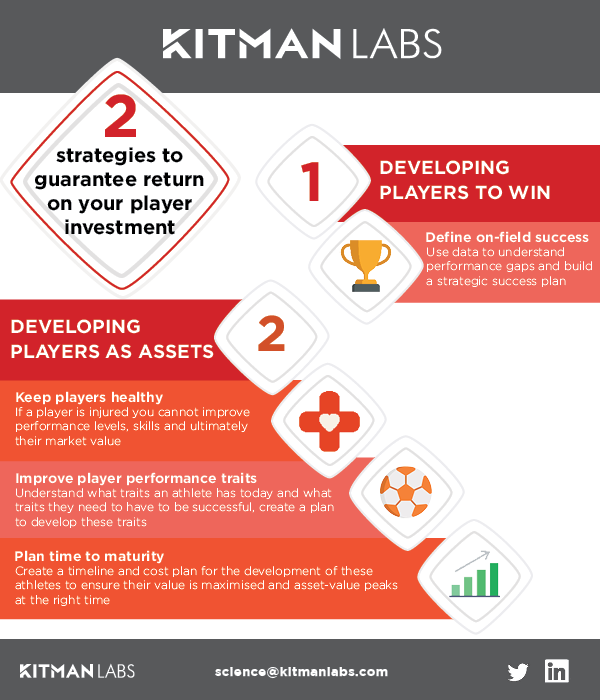Business is all about return on investment and the business of sport is no exception.
For football clubs, it is often the big investments into talent recruitment that can make or break the business. In fact, many teams try to manage the cost of player recruitment by developing talent through their academies, making talent development a pivotal part of their revenue strategy.
For many clubs, football academies are a worthwhile investment when they produce a high proportion of elite footballers who go on to fit into one of two categories:
Athletes who progress to the senior team and contribute to performance.
Athletes who are developed as assets and are sold/traded to or with other clubs.
With player wages and recruitment fees costing clubs more than 60% of their annual revenue, many organisations have begun to focus more on developing players that will progress to their first team. Yet to accurately develop talented players and guarantee success on the field, teams first need to understand what it takes to win.
Within your league or competition, what are the key performance indicators that define success? By understanding what attributes of game play will lead to success, teams can benchmark their current talent against the level of talent that is required to succeed.

From this, training and performance programmes can be refined so that talent with appropriate qualities is developed. By using data to understand the performance gaps and subsequently build a strategic success plan, teams can control their own destiny and maximise the business’s ROI.
If the player is not destined to join the first team, then the club should still look to maximise their return by developing the player’s value for other teams. If that is the case, then there are some important components to consider to ensure that your investment will still be maximised.
The first component is health. If a player is injured, you cannot improve their performance and skill levels which will ultimately reduce their market value, so keeping players healthy is key.
Another component is performance. To maximise improvements in performance we need to understand what traits an athlete has today, what traits they need to be successful (i.e. what traits do the best players in that position, in the world, in your league, in your team, have?) and then you need to understand how your training programme and long-term athlete development (LTAD) model affects these traits.
Whilst many teams believe they have a strong LTAD model and the resources to support it, any successful athlete pathways programme will not have a one-size-fits-all approach. LTAD models need to be as unique as the athletes involved in them. For example, the skills required of a Premier League defender are different to that of a Premier League striker. Are your current LTAD models improving them as athletes or are they laser focused on developing the specific traits that will make an athlete a top-class Premier League player?
Lastly, like any investment, you need to understand your time to maturity. How long it will take and how much it will cost to get a return?
When thinking about the two options for athlete development, the successful business set-up of Manchester United’s Academy immediately comes to mind. Not only did United have almost twice as many youth Academy products playing in the Premier League than any other club last season (29 compared to joint-second placed teams Southampton and Tottenham with 16), the transfer fees received by the Red Devils for former Academy players now playing for other Premier League teams totals almost €50 million.
With these players’ current market value estimated to be over €126 million, United’s coffers could be further boosted by sell-on fees. At Old Trafford, players are kept healthy and given the correct performance plan with an end goal insight. When players of the requisite quality are identified within their ranks, like England internationals Marcus Rashford and Jesse Lingard, there is a pathway to the senior squad, thus potentially saving millions in the transfer market.
What is the best way to get started?
By asking the right questions and leveraging data that is being collected by teams today, the insights required to develop your athletes can be generated.
To start, some of the questions teams could ask include:
Have you set targets for your academies to support your revenue strategy?
How many players do you want to develop for your own team?
How many players do you want to develop as an asset?
To support this strategy, do you have the correct processes in place to maximise the health and performance of your player investments?
Furthermore, do you know what performance traits it takes to win or what performance traits will increase the value of your investment for a future trade?
Would investing more create greater returns, or is the deadline on your investment approaching?
Getting deeper insight into your investments and strategies ensures you are focusing on the right areas whilst improving the qualities that allow you to develop a world class asset or performer. By doing this your business will absolutely succeed in getting the best return on investment.
For further information about how Kitman Labs can help your club harness the power of data to develop players, visit www.kitmanlabs.com or follow @KitmanLabs on Twitter and LinkedIn
To listen to Kitman Labs’ Game Changer podcasts: www.kitmanlabs.com/game-changer-podcast/
About the author:
Stephen Smith is the CEO and Founder of Kitman Labs, a sports science technology company that works with over 155 elite sporting teams worldwide. Kitman Labs’ award-winning Athlete Optimization System™, which won the inaugural Performance Technology of the Year prize at the prestigious BT Sport Industry Awards 2018, uses machine learning and artificial intelligence to unlock unique insights about health and performance that helps elite sports teams succeed on and off the field.





